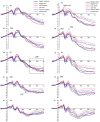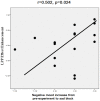Negative mood state enhances the susceptibility to unpleasant events: neural correlates from a music-primed emotion classification task
- PMID: 24587070
- PMCID: PMC3938531
- DOI: 10.1371/journal.pone.0089844
Negative mood state enhances the susceptibility to unpleasant events: neural correlates from a music-primed emotion classification task
Abstract
Background: Various affective disorders are linked with enhanced processing of unpleasant stimuli. However, this link is likely a result of the dominant negative mood derived from the disorder, rather than a result of the disorder itself. Additionally, little is currently known about the influence of mood on the susceptibility to emotional events in healthy populations.
Method: Event-Related Potentials (ERP) were recorded for pleasant, neutral and unpleasant pictures while subjects performed an emotional/neutral picture classification task during positive, neutral, or negative mood induced by instrumental Chinese music.
Results: Late Positive Potential (LPP) amplitudes were positively related to the affective arousal of pictures. The emotional responding to unpleasant pictures, indicated by the unpleasant-neutral differences in LPPs, was enhanced during negative compared to neutral and positive moods in the entire LPP time window (600-1000 ms). The magnitude of this enhancement was larger with increasing self-reported negative mood. In contrast, this responding was reduced during positive compared to neutral mood in the 800-1000 ms interval. Additionally, LPP reactions to pleasant stimuli were similar across positive, neutral and negative moods except those in the 800-900 ms interval.
Implications: Negative mood intensifies the humans' susceptibility to unpleasant events in healthy individuals. In contrast, music-induced happy mood is effective in reducing the susceptibility to these events. Practical implications of these findings were discussed.
Conflict of interest statement
Figures







Similar articles
-
Music-induced mood modulates the strength of emotional negativity bias: an ERP study.Neurosci Lett. 2008 Nov 14;445(2):135-9. doi: 10.1016/j.neulet.2008.08.061. Epub 2008 Aug 28. Neurosci Lett. 2008. PMID: 18771704
-
Emotional modulation of the late positive potential (LPP) generalizes to Chinese individuals.Int J Psychophysiol. 2010 Mar;75(3):319-25. doi: 10.1016/j.ijpsycho.2009.12.014. Epub 2010 Jan 15. Int J Psychophysiol. 2010. PMID: 20079772
-
Impaired cognitive reappraisal in panic disorder revealed by the late positive potential.Neuroreport. 2016 Jan 20;27(2):99-103. doi: 10.1097/WNR.0000000000000504. Neuroreport. 2016. PMID: 26656936
-
Implicit and explicit categorization of natural scenes.Prog Brain Res. 2006;156:53-65. doi: 10.1016/S0079-6123(06)56003-0. Prog Brain Res. 2006. PMID: 17015074 Review.
-
Temporal dynamics of affective scene processing in the healthy adult human brain.Neurosci Biobehav Rev. 2025 Feb;169:106003. doi: 10.1016/j.neubiorev.2025.106003. Epub 2025 Jan 3. Neurosci Biobehav Rev. 2025. PMID: 39755291 Review.
Cited by
-
Feedback-related negativity in children with two subtypes of attention deficit hyperactivity disorder.PLoS One. 2014 Jun 16;9(6):e99570. doi: 10.1371/journal.pone.0099570. eCollection 2014. PLoS One. 2014. PMID: 24932610 Free PMC article.
-
Different timing features in brain processing of core and moral disgust pictures: an event-related potentials study.PLoS One. 2015 May 26;10(5):e0128531. doi: 10.1371/journal.pone.0128531. eCollection 2015. PLoS One. 2015. PMID: 26011635 Free PMC article.
-
The neural mechanisms underlying the aging-related enhancement of positive affects: electrophysiological evidences.Front Aging Neurosci. 2015 Aug 6;7:143. doi: 10.3389/fnagi.2015.00143. eCollection 2015. Front Aging Neurosci. 2015. PMID: 26300770 Free PMC article.
-
The time course of emotional picture processing: an event-related potential study using a rapid serial visual presentation paradigm.Front Psychol. 2015 Jul 9;6:954. doi: 10.3389/fpsyg.2015.00954. eCollection 2015. Front Psychol. 2015. PMID: 26217276 Free PMC article.
-
The influence of affective state on exogenous attention to emotional distractors: behavioral and electrophysiological correlates.Sci Rep. 2017 Aug 14;7(1):8068. doi: 10.1038/s41598-017-07249-x. Sci Rep. 2017. PMID: 28808233 Free PMC article.
References
-
- Krompinger JW, Simons RF (2009) Electrophysiological indicators of emotion processing biases in depressed undergraduates. Biol psychol 81 (3) 153–163. - PubMed
-
- Gotlib IH, Krasnoperova E, Yue DN, Joormann J (2004) Attentional biases for negative interpersonal stimuli in clinical depression. J abnorm psychol 113 (1) 127. - PubMed
-
- Mathews A, Mogg K, Kentish J, Eysenck M (1995) Effect of psychological treatment on cognitive bias in generalized anxiety disorder. Behav Res Ther 33 (3) 293–303. - PubMed
-
- Mercado F, Carretié L, Tapia M, Gómez-Jarabo G (2006) The influence of emotional context on attention in anxious subjects: neurophysiological correlates. J anxiety disord 20 (1) 72–84. - PubMed
-
- Williams LM, Kemp AH, Felmingham K, Liddell BJ, Palmer DM, et al. (2007) Neural biases to covert and overt signals of fear: dissociation by trait anxiety and depression. J Cogn Neurosci 19 (10) 1595–1608. - PubMed
Publication types
MeSH terms
LinkOut - more resources
Full Text Sources
Other Literature Sources

